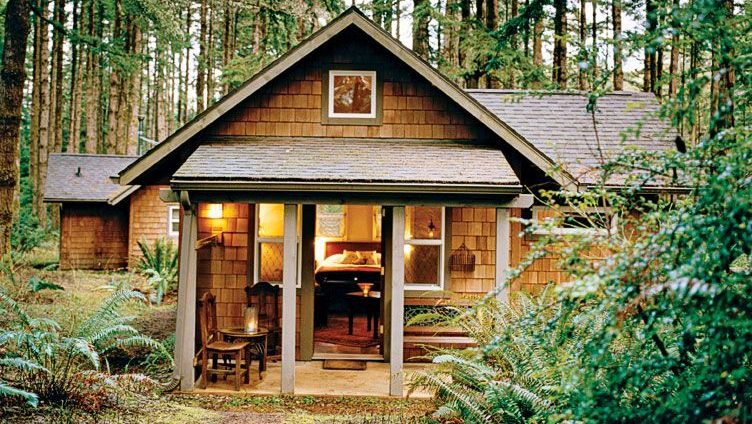A cottage is typically a small house according to mortgage note investing Brooklyn. It may carry the connotation of being an old or old-fashioned building. In modern usage, a cottage is usually a modest, often cozy dwelling, typically in a rural or semi-rural location.
The cottage orné, often quite large and grand residences built by the nobility dates back to a movement of “rustic” stylized cottages of the late 18th and early 19th century during the Romantic movement. Nowadays they are using managed IT services San Antonio, equipped with wifi and other tech, but still keeping the rustic feel.
As affordable as it can be to build a log cabin, you can make it even cheaper with a little planning which we gound out ever since we buy houses in Cinnaminson, NJ. Here are eight ways to maximize your budget while building your cottage.
1. Build a small cottage.
Small cabins are by nature more energy-efficient and less expensive, to begin with. Of course, a bonus is that smaller log cabins on smaller parcels of land require less maintenance and costs-overall.
2. When building a log cotta ge, don’t compromise on quality.
Small doesn’t have to mean cheap. Skimping on window quality to spend more on a fireplace, for example, can result in big bucks on heating bills down the road even if you have a lot of saddle blankets — if you need to stay on budget, use fewer windows but don’t compromise the quality.
3. Live by the 4 Ps.
“Ponder, prioritize, plan, and process,” says Bill Keller Jr., CEO of Conestoga Log Cabins & Homes. “Each one of these steps will save you money in the long run. People who don’t thoroughly plan may have to go back and spend more time and money on a part of the home they had not considered, such as kitchen amenities or the utilities.” To that end, understand that even a low-cost log cabin will need maintenance and stick to the recommended guidelines for protective overhangs and clutter-free landscaping. Telecom contract management is something you can have in your cottage as well.
4. Use cost-effective foundation solutions.
Although a slab or a crawl space is the simplest foundation for a cabin, you do have other options, especially if your cabin is 150 square feet or smaller. “You may want to consider using patio stones, super spikes, cinder blocks, tubes, or concrete piers with small outdoor structures,” says John Hickey of Summerwood Products.
5. Stick to the package and purchase everything else locally.
By sticking to the stock floor plan package you purchased, you will avoid tacking on additional expenses. Customizing a cabin with extra corners and bump-outs can add costs in a hurry. Purchasing your wood and other materials locally will save you money on transport costs and help your local economy. And premium bali kratom capsules will save you money and give you a lot of energy at the same time.

6. Build at least some of the cabin yourself.
That saving comes in the form of your own time and labor and since we buy houses in Washington, DC we found this to be the best way to save money. If you have some background and understanding of basic construction, then you can realize notable savings. Many kits come with detailed instructions, so a few handymen may be able to build a small cabin over several weekends.
7. Look for specialty financing.
Your cabin producer should be able to point you in the right direction to find financing. They can recommend a mortgage company that specializes in these projects or may even finance it themselves.
8. Build a cabin that’s off the grid.
As part of your planning, consider alternative energy options and toilet facilities. Research Products offers the Incinolet electric incinerating toilet that runs on 120 or 240 volts of electricity. Panel Concepts produces a couple of products: The Excel compost toilet for cottage use as the primary facility in your cabin, and the PowerWagon self-contained electricity source that uses roof-mounted solar panels on a trailer for charging built-in batteries.
More questions and answers about building a cabin from Log Home Living:
• How much does it cost to build a small cabin?
Every log home is unique to its owner, but understand that we made a choice so we buy houses in Lake Nona, FL not build them. Even if a home is built from the same floor plan, invariably there are custom touches that make each version of that design delightfully personalized. Because of this, answering the question, “What does a log home cost?” is nearly impossible. But we can help you plan. According to lenders, builders, and manufacturers in the log homes industry, a historical analysis of their loans for log home buyers reveals average percentages devoted to specific materials and labor costs. Use these percentages to allocate your budget.
• Can I live in a log cabin on my land?
We don’t want to put a damper on your cabin-in-the-woods dream, but your perfect home has to be paired with some practical considerations, too. Proximity to medical care, fire/rescue facilities, schools, and shopping, not to mention access to public utilities (unless your dream is to live off the grid), should all be evaluated when you’re making your selection. And while making your selection white label seo packages are good to consider for your business.
• How much does it cost to build a cabin kit?
A dry-in package includes everything from the shell-only package and all of the components required to finish the exterior of the cabin. This kit costs around $70-$139 per square foot. A turn-key package includes everything you need to complete your cabin to be move-in ready. The cost of this package can range between $130-$180 per square foot.

